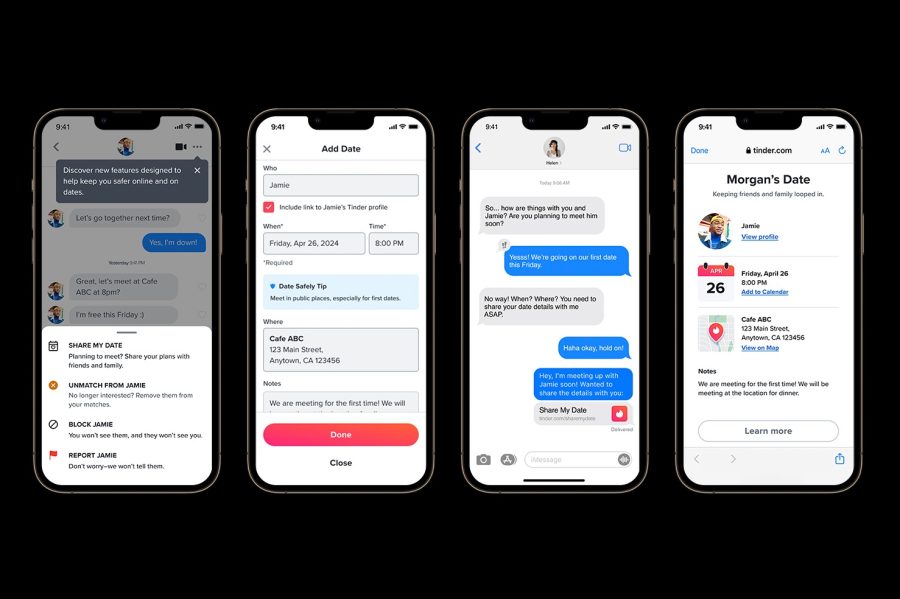Editor’s note: We offer our long-term sponsors the opportunity to write posts and tell their story. These posts are clearly marked as written by sponsors, but we also want them to be useful and interesting to our readers. We hope you like the posts and we encourage you to support our sponsors by trying out their products.

Apple versus Adobe. Facebook versus Google. Twitter versus its own developer ecosystem. At the recent Web 2.0 Expo in San Francisco keynotes and hallway conversations revolved around the latest platform battles that are actively defining and re-imagining the future of our increasingly mobile, social, and real-time reality.
But technology platforms such as AOL, Microsoft, Amazon, Yahoo, and eBay have been experiencing these cycles for years, spawning large ecosystems that in turn created huge opportunities for partners, developers and competitors. Evolution is inherent in any ecosystem and today’s platform battles are just one spike in the Web 2.0 maturation curve.
Observing the renaissance of social ad platforms (note AdMob, the launch of iAd, Promoted Tweets) we at Mashery realize that while analysts and media remark on corporate goings-on, there has been a lack of interest in understanding the developer community that is a meaningful part of the 2010 platform wars.
Mashery, an API infrastructure and management company, polled nearly 600 Web and mobile application developers at SXSW Interactive this spring to take a pulse on what they love and hate about developing on different API platforms. By peering into the mindset of a developer building applications with APIs, we extrapolated ecosystem insights and presented them to you here.
API Leader Mashery Captures Application Developer Trends with Developer Pulse
View more
from
.
The Questions
- What are the best APIs out there for developers?
- What are the most helpful resources to you as developers?
- Why do you work with APIs?
- What programming languages are you using?
- What platforms and devices do you build applications for?
Findings & Implications
1. APIs have a compelling long tail
What are the best APIs out there for developers? There is no real surprise when we announce that the top three APIs named as the best to work with are Google, Twitter, and Amazon (69% of respondents). But interestingly, we see a solid number of smaller platform players emerging.
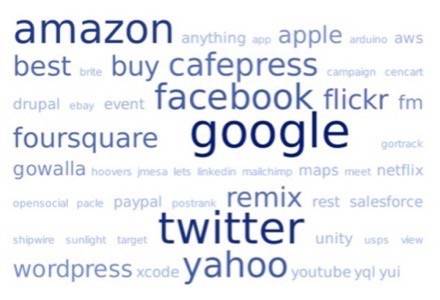
Tag cloud based on 828 responses from 502 developers.
If you’re a current API provider, or you’re thinking of advancing an API program by opening up your data to developers, there’s plenty of room for targeting the niche of your business. Since the landscape of the API providers is not conducive to a winner takes all conclusion, there is a thriving, healthy long tail of developers who are interested in new platforms and creative innovation. The secret sauce is in the type of data you expose, and how simple you make it to access your data.
So don’t be a five-year-old on the soccer field, flocking to the latest shiny object. Play your position, and stay focused on your core audience. Think about it: When Chris Anderson first established his The Long Tail theory, the premise was that overcoming the limitations of geography and scale will enable you to discover new markets and expand existing ones – because there’s an audience for everything, and “popularity no longer has a monopoly on profitability.”
“Going by past evidence, [even] closed ecosystems… still allow for opportunities to be made at the edge of the ecosystem in areas the platform owner deems too small to bother with,” writes VentureBeat.
With nearly 2,000 APIs listed on ProgrammableWeb, there is more room for compelling data to be re-mixed and re-used into different user experiences across multiple devices.
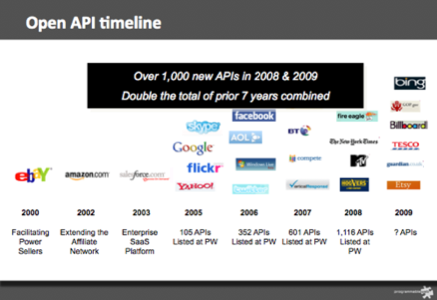
ProgrammableWeb.com, Business of APIs Conference, November 2009
2. Open platforms and closed communications don’t always mix well
What developer resources are most helpful when building with APIs? If you want to better communicate with your developer community, it’s a senseless exercise to compare apples and oranges, but Apple to Twitter – valuable lessons learned.
Apple:
Host an annual developer event and fail to mention major policy changes around Flash and HTML5 that hugely impact the ecosystem’s development process on the platform. Instead, institute changes in the Terms of Services and let developers dig through and work out the edits on their own. Message: “Dear community, our policies are public and open. Have at them.”
- “It’s hard to build a business on a platform where you feel like you cannot trust the men in power. If they can take down Adobe a few days before the launch of their flagship product, what hope do smaller players hold?” – David, 37signals
Twitter:
Launch a developer event for the sake of talking to your growing ecosystem and present a roadmap, have executives communicate policy on stage, from the top down. Inform developers of where opportunities lie while being honest about which pieces of the pie Twitter will keep for themselves. Message: “Dear community, we want to help you grow by being transparent on where we are headed as an organization.”
- “For every platform ever, it’s a question of what should be left up to the ecosystem and what should be created on the platform.” – Ev Williams, CEO, Twitter
And when we asked the community what is most helpful to them as developers, what was most reflected was a growing demand for clear cut communication from API providers:
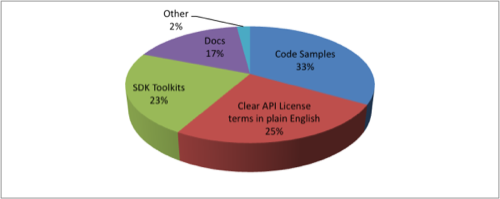
Chart based on 1072 responses from 542 developers.
In the ‘Other’ category, we heard what developers had to say about their API pet peeves:
- I “hate it when [the] API stops working without notice.”
- I want “clear, updated information” and “stability and company ethics towards developers.”
- It’s an important signal when “CEOs work with developers.”
- Provide timely bug fixes, “working tutorials, demos and BBS, and sample apps” on the developer portal.
- Create a “vibrant community” with “online message boards” and helpful “blogs and videos.”
As an API platform provider, knowing more about who your developers are and what they rank highest in importance is the best indicator for resource prioritization. Build support tools that your ecosystem actually wants, or needs. It’s human nature to flock towards the friendliest habitat for growth and survival.
3. Passion first. Paycheck second.
Why do developers work with APIs? The Valley is filled with startups and garage coders with a vision of how to do something better, paired with the energy, drive, and desire to build the next great thing. Entrepreneurs may dream sweet dreams of fame and riches but at the core of Silicon Valley, Silicon Alley, and everywhere in between is solving a problem in a technically elegant way in front of your peers. That is its own reward.
We asked the community, “Why do you work with APIs?”
The results:
Additionally, of the 569 responses from developers attending SXSW this year, more than a quarter of them came from companies with 30 plus employees, which demonstrates interest and support for API initiatives from larger organizations. Almost 1/5 of developers attended SXSW Interactive for their “own personal projects,” and nearly 2/3 cited reasons beyond “because my employer pays me to,” which demonstrates personal dedication to the field.
4. Ebb and Flow of Disrupted Ecosystems
One thing we were very interested in when we laid out our questions to this community was figuring out which were the most popular programming languages.
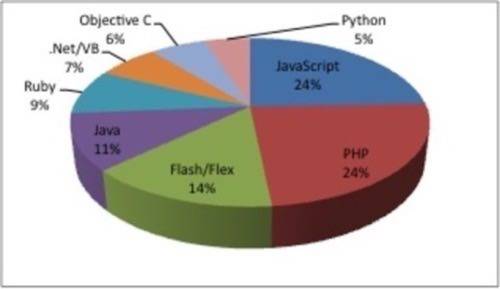
Chart based on 1416 results from 530 developers
Web scripting languages like PHP and Javascript (not surprisingly) dominated amongst the developers working with APIs that we polled at SxSWi 2010, capturing almost 50% of our sample. But programming languages are subject to changes when large platforms claim their support or remove their support and disrupt the ecosystem. What impact will Apple’s stance on Flash have versus HTML5? As app development on mobile devices continues to build momentum, will Objective-C continue to rise at the expense of Java or Windows languages? Apple’s platform guidelines require all apps to be built in Objective-C – a fact that particularly noteworthy considering the exploding need for new and refurbished iPad applications.
5. Developers migrate toward where they find opportunity
Where are developers building apps and extending into new devices and channels?
The results:
The implications:
- Online/browser and Mobile are clearly the dominant development platforms with almost 3/4 of survey responses.
- Desktop and Set-top and Gaming Consoles have yet to attract strong developer adoption. Currently, only the Xbox360 console is open to scalable app integrations, while Adobe AIR and Microsoft Silverlight are still waiting to take off as market opportunities.
- Only 3% of this developer population is focused on hardware, but we expect that to change as major mobile operators and manufacturers supply more app-friendly handsets into the hands of mainstream consumers.
When you are an API provider, it is important to periodically check-in with the developers consuming your APIs to gage the pulse of your developer ecosystem, particularly in times of turbulence like today. Our developer pulse revealed that:
- APIs have a compelling long-tail
- Open platforms and closed communications don’t always mix well
- Passion first. Paycheck second.
- Ebb and flow of disrupted ecosystems
- Developers migrate toward where they find opportunity
We think that the recent comments by venture capitalist Fred Wilson apply to the wider context of developer platforms in this latest era of platform battles: “It is clear you can build large businesses on top of a social platform like Facebook and Twitter… We are entering a new phase now. Twitter is a global platform… so it’s time for Twitter and its developer ecosystem to work together to create entirely new things that will shape the Internet in the coming years. I’m excited to see it happen.”







